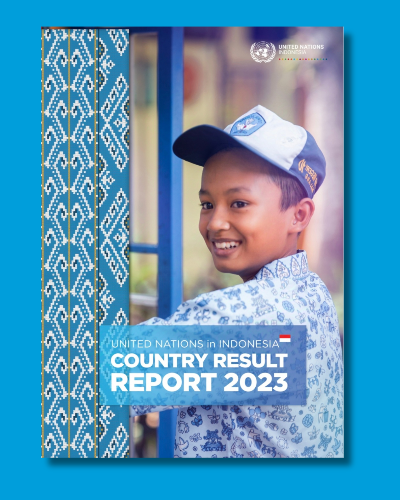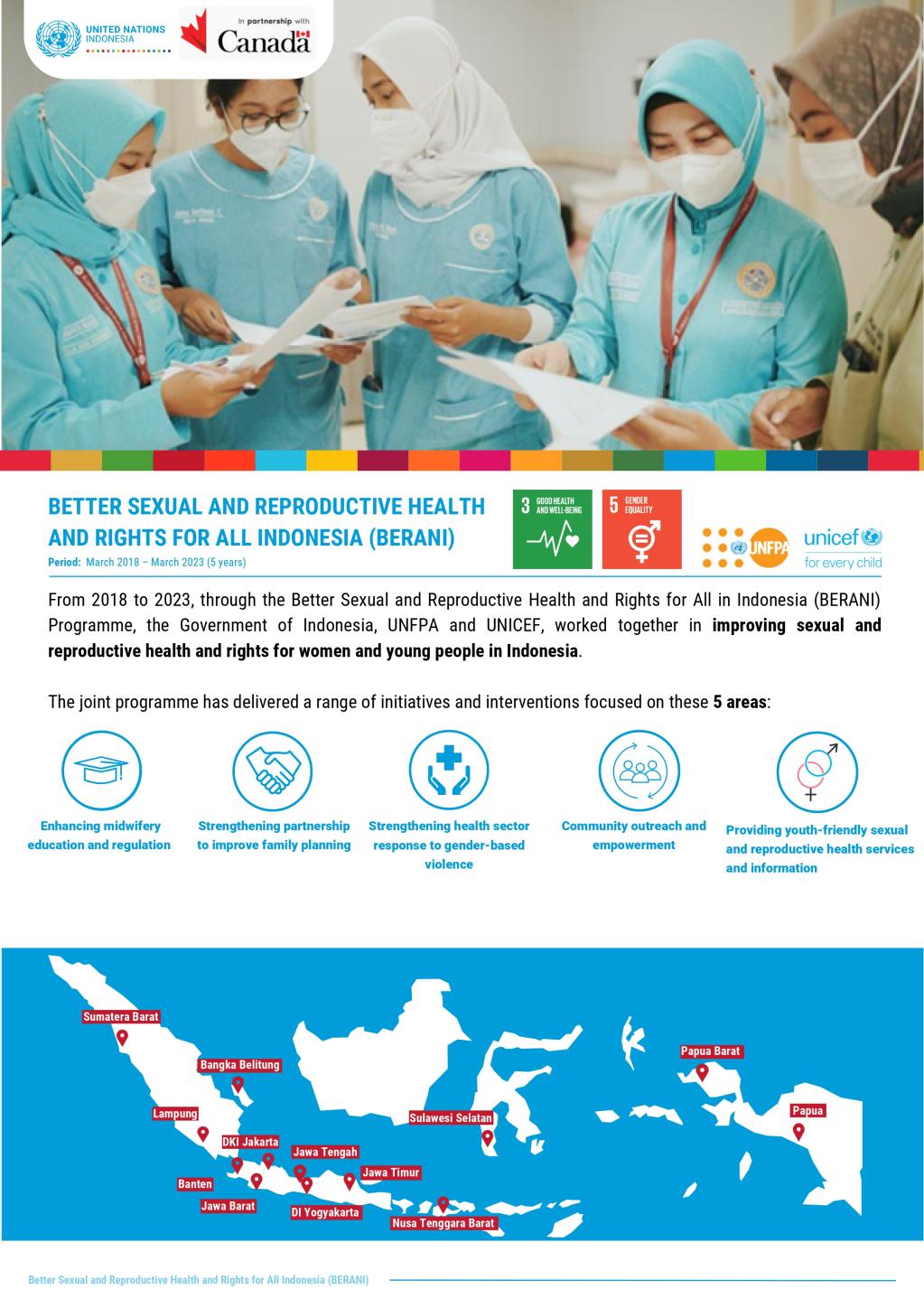Latest
09 August 2025
International Day of The World’s Indigenous Peoples 2025, Secretary-General's Message, António Guterres
30 July 2025
World Day Against Trafficking in Persons 2025, Secretary-General's Message, António Guterres
29 July 2025
Unlocking Sustainable Investments for Home-Grown School Meals - Deputy Secretary-General's Speech, Amina J. Mohammed
Latest
The Sustainable Development Goals in Indonesia
For a comprehensive look at the UN's initiatives and Indonesia's progress towards the SDGs, please download the full report below.








About UNDP
UNDP is the leading United Nations organization fighting to end the injustice of poverty, inequality and climate change. Working with our broad network of experts and partners in 170 countries, we help nations to build integrated, lasting solutions for people and the planet. Learn more at undp.org or follow at @UNDP.About DEN
The National Economic Council of the Republic Indonesia (DEN) is a non-structural government body under and responsible to the President of the Republic of Indonesia. DEN is tasked with providing support and recommendations to the President in accelerating the implementation of strategic policies and priority programs in the economic sector.Media Contacts
Nabilla Rahmani, Head of Communications UNDP Indonesia (Nabilla.rahmani@undp.org)
The program will support the development of coherent policies, frameworks, and strategies at national and regional levels to help minimize the loss of primary forests and promote the recognition of other effective area-based conservation mechanisms in primary forest landscapes. The regional coordination project will enhance collaboration and south-south cooperation to facilitate knowledge exchange, technical support, and capacity development for improved management of primary forests across borders.The program is one of five GEF integrated investments for primary forests under the GEF-8 replenishment. The program will connect with the GEF-8 Critical Forest Biomes Integrated Programs for the Amazon, Guinean Forests, Mesoamerica, and the Congo Basin to drive global systems change in globally important tropical forest landscapes.“Conserving primary tropical forests is the best response to the urgent environmental crisis that is a threat to human well-being globally and doing so can support green development. This program embodies strong commitment and political will to address the drivers of forest loss in proactive and innovative ways. These efforts have many benefits for human development as well as for ecosystems and are fully aligned with implementation of the Kunming-Montreal Global Biodiversity Framework.” - Mr. Carlos Manuel Rodríguez, GEF CEO and Chairperson“The Indo-Malayan Forest biome is one of the world’s most ancient and ecologically rich ecosystems — a living reservoir of biodiversity, culture, and climate resilience. With growing pressure on these forests, this new program offers a timely and transformative opportunity to turn the tide. By uniting governments, regional and international organisations, civil society, and the private sector, we are building a cohesive framework for transboundary collaboration that will amplify conservation impact across the entire Indo-Malayan region. IUCN is proud to contribute to this collective effort, bringing our global expertise, trusted knowledge products, and proven tools to the table.” - Dr Grethel Aguilar, IUCN Director General“These primary forests provide essential services to the whole region, especially rural communities who depend on forest resources for their livelihoods and food security. This Integrated Program boosts regional action to conserve, protect, restore and promote sustainable use of precious primary forest landscapes in Southeast Asia and the Pacific, where most remaining primary forests are located outside any formal protection status. This collaboration across countries and organizations will drive down the risks of biodiversity loss and climate change for better production, better nutrition, better environment, and better life.” - Mr. Alue Dohong, FAO Assistant Director-General and Regional Representative for Asia and the Pacific About IUCNIUCN is a membership Union composed of both government and civil society organisations. It harnesses the experience, resources and reach of its more than 1,400 Member organisations and the input of more than 17,000 experts. IUCN is the global authority on the status of the natural world and the measures needed to safeguard it.
www.iucn.orgAbout FAOFAO is a specialized agency of the United Nations that leads international efforts to defeat hunger. As a partner agency for the GEF, FAO supports countries worldwide in addressing the complex challenges at the nexus between the agrifood systems and the environment. Since 2006, FAO has supported 141 countries in accessing nearly $2 billion in grants for projects that respond to local priorities, deliver global environmental benefits, and advance the Sustainable Development Goals.
www.fao.org/GEFAbout the GEFThe Global Environment Facility (GEF) includes several multilateral funds working together to address the planet's most pressing challenges in an integrated way. Its financing helps developing countries address complex challenges and work towards meeting international environmental goals. Over the past three decades, the GEF has provided more than $26 billion in financing, primarily as grants, and mobilized another $153 billion for country-driven priority projects.
www.thegef.orgContact:Tiy Chung, FAO Regional Communications Officer for Asia and the Pacific, tiy.chung@fao.orgArdila Syakriah, FAO Indonesia National Communications Specialist, ardila.syakriah@fao.org / +6282230428291
and 2025 Global Trend: https://www.unhcr.org/global-trends, in advance of World Refugee Day, observed annually on June 20.There were 122.1 million forcibly displaced people by the end of April 2025, up from 120 million at the same time last year, representing around a decade of year-on-year increases in the number of refugees and others forced to flee their homes. The main drivers of displacement remain large conflicts like Sudan, Myanmar, and Ukraine, and the continued failure to stop the fighting. Filippo Grandi, UN High Commissioner for Refugees, said: “We are living in a time of intense volatility in international relations, with modern warfare creating a fragile, harrowing landscape marked by acute human suffering. We must redouble our efforts to search for peace and find long-lasting solutions for refugees and others forced to flee their homes.” Forcibly displaced people include people displaced within their own country by conflict, which grew sharply by 6.3 million to 73.5 million at the end of 2024, and refugees fleeing their countries (42.7 million people). Sudan became the world’s largest forced displacement situation with 14.3 million refugees and internally displaced people (IDPs), replacing Syria (13.5 million), and followed by Afghanistan (10.3 million) and Ukraine (8.8 million). The report found that, contrary to widespread perceptions in wealthier regions, 67 per cent of refugees stay in neighbouring countries, with low and middle-income countries hosting 73 per cent of the world’s refugees. Indeed, 60 per cent of people forced to flee never leave their own country. While the number of forcibly displaced people has almost doubled in the last decade, funding for UNHCR now stands at roughly the same level as in 2015 amid brutal and ongoing cuts to humanitarian aid. This situation is untenable, leaving refugees and others fleeing danger even more vulnerable. “Even amid the devastating cuts, we have seen some rays of hope over the last six months,” Grandi added. “Nearly 2 million Syrians have been able to return home after over a decade uprooted. The country remains fragile, and people need our help to rebuild their lives again.” In total, 9.8 million forcibly displaced people returned home in 2024, including 1.6 million refugees (the most for more than two decades) and 8.2 million IDPs (the second highest ever). Many of these returns, however, happened in an adverse political or security climate. For example, a large number of Afghans were forced to return to Afghanistan in 2024, arriving home in desperate conditions. In countries like the Democratic Republic of the Congo, Myanmar, and South Sudan, there were significant new forced displacements at the same time as the return of refugees and IDPs. The report calls for continued funding of UNHCR programmes that save lives, assist refugees and IDPs returning home, and reinforce basic infrastructure and social services in host communities, as an essential investment in regional and global security. For more information, please contact:
Mitra Suryono, suryono@unhcr.org, +62 811 1960 0493
Where we work: The UN’s programmatic interventions
The UN is implementing 0 programmatic interventions during the ongoing programme cycle. The map below displays the number of programmatic interventions per location (note that a programmatic intervention may be linked to more than one location). Click on the number on the map to get a summary description of the programmatic interventions. Programmatic interventions may be linked to the national level or specific locations/sub-national level. Note that some interventions linked to specific locations might also have components at the national level, even if they are not categorized as country-level interventions. Click on “Show location details” in the bottom right corner to view a summary table with locations, the number of programmatic interventions, and the UN entities working in those locations. For definitions of programmatic interventions, please refer to the Glossary section.




























